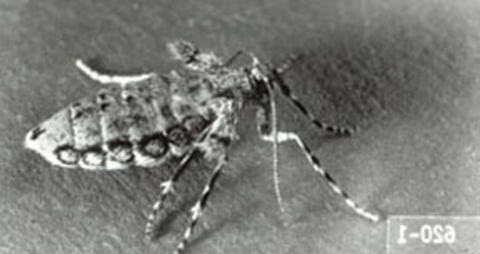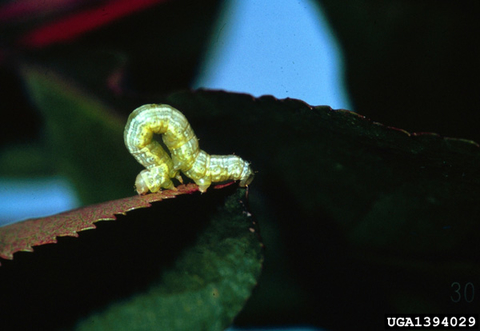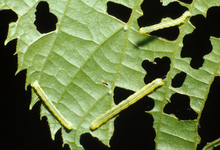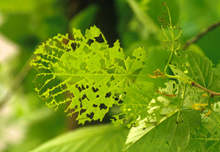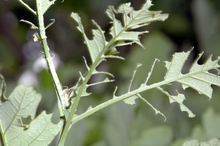Quick facts about spring and fall cankerworms
Cankerworms (inchworms) cause defoliation in shade trees. They are found on elm, apple, hackberry, basswood, oak, boxelder, maple and ash trees as well as shrubs growing beneath heavily infested trees.
- Young, newly transplanted, or weak trees have more chances of injury from defoliation.
- If a tree is defoliated for three consecutive years, the branches of the tree can die, making the tree very weak.
- Pesticides can be used when the caterpillars are small (around the second week of feeding), for two reasons:
- to protect trees
- to eliminate the presence of cankerworm moths around homes
Cankerworms go through natural cycles with two to seven years of high populations (average of four years). This is followed by a period of 13 to 18 years, of low populations.
Spring and fall cankerworms have not had a significant population outbreak since the late 1970s. This could be due to the reduced number of elm trees in Minnesota (preferred host for cankerworms). Elm population is decreasing due to Dutch elm disease, and the remaining trees cannot support large numbers of cankerworms.
How to identify cankerworms
Adult cankerworms
Spring and fall cankerworms look very similar. There are slight differences in markings and size between the two species that are difficult to detect.
- Adult females of both species are wingless, giving them a spider-like appearance.
- They are both grayish brown and about 5/16 of an inch long.
- Males have grayish brown wings and an average wingspan of 1 1/8 inches long.
Larvae
The larvae also look very similar. Full-grown cankerworms are about 1 inch in length and can vary in color.
- Spring cankerworms can be yellow-green to brownish to blackish. A white stripe may run along the side of the body, all the way from the head to the back end of the body.
- Fall cankerworms range from light green to dark green to black.
The two species differ in the number of prolegs (false legs) on the back half of the abdomen. Fall cankerworms have three, but, spring cankerworms have only two prolegs.
Life cycle of cankerworms
Fall and spring cankerworms feed in a similar way, but have different life cycles.
Fall cankerworm
This species comes out from the soil as an adult moth, generally in late October after a hard freeze. The male moths emerge a few days before the females.
- Mating takes place as the females crawl up tree trunks in search of small twigs to lay egg clusters.
- The males and females die after the eggs are laid.
- Eggs stay on trees throughout the winter and hatch in the spring.
Egg-hatch varies from late April to mid-May depending on weather conditions. It is normally around the time elm buds open.
- Newly hatched larvae are less than 1/16 of an inch long, and spin silk threads that allow them to easily blow from tree to tree.
- They reach full-grown length in about four weeks.
- Larvae then drop to the ground and transform into pupae, in the soil.
- Later in the season, pupae give rise to adults.
Spring cankerworm
- The pupae in the soil do not emerge as adult moths until early spring. The winged males and wingless females emerge during the third week in March in the Twin Cities area.
- Eggs deposited as loose clusters in bark cracks and under bark scales are not easily seen.
- Spring and fall cankerworm eggs hatch about the same time in the spring and the larvae follow a similar life cycle.
Damage caused by cankerworms
Spring and fall cankerworms feed at the same time of year on the same trees causing the same kind of damage.
- feed on buds and expanding leaves right after egg hatch in the spring
- create small BB-sized holes (about 4.4 mm) in the leaves
- as the larvae grow, holes get bigger until all the tissue between the veins is eaten up
Environmental nuisance
Large numbers of caterpillars spinning to the ground on silken threads, crawling or falling on picnic tables, doors, walks and/or house siding can create an unpleasant environment.
- This stage lasts for only about a week and cankerworms cannot be controlled at this time.
- May also create a nuisance during the spring and fall as moths crawl up the exterior walls of homes. Nothing can be done at this stage to get rid of cankerworms.
Affecting tree growth
Cankerworms chew small holes on leaves.
- They chew between veins first, then leaf tissue (except for major veins), and eventually chew up all of the leaf (except the midvein)
- Feeding can cause complete defoliation of a tree.
- A mature, strong tree can survive one to two seasons of complete defoliation, but more than three years of cankerworm feeding can cause the branches to die.
How to protect your trees from cankerworms
Using pesticides
Assess a tree's age, size, strength and previous history of defoliation when choosing a control method.
- The best time for chemical treatment is in the second week of feeding when:
- the damage is minor
- the caterpillars are still small (less than 1/2 inch)
- the leaves have fully expanded
- Look at your trees closely, because cankerworms and their damage might not be seen so easily.
- After eggs hatch, cankerworms grow rapidly for three to four weeks. They feed on large parts of the leaves and only the veins of the leaves remain, when the damage is severe.
- Treatment is not effective after you notice severe damage. Pesticides can irritate the cankerworms and cause them to drop from trees in larger numbers.
How to apply pesticides
Follow these steps to control spread of cankerworms:
- Determine egg-hatch date by following either of these steps:
- Find fall cankerworm egg masses and observe them during early spring for signs of hatching (hatched eggs will have a hole in the center)
- Look at foliage of several trees for the first signs of young cankerworms or their feeding.
- Add 10 days to the date of hatch (as found in step one). This will be the best date for spraying.
- Look at few trees during the 10-day post-hatch period, to check if development has slowed or quickened because of weather conditions.
- Modify the spray date as necessary. Remember that the worms should be less than 1/2 inch in length and that at least 50% of the leaf surface should be intact.
- Spray with one of the suggested materials.
Types of pesticides
Several pesticides are effective for treating cankerworms when applied at the correct time. Examples of active ingredients of pesticides are:
carbaryl
cyfluthrin
esfenvalerate
malathion
permethrin
Use the bacterial insecticide Bacillus thuringiensis, whenever possible. Bacillus thuringiensis must be applied while the cankerworms are still small (less than 1/2") to get good results.
- environment friendly, non-chemical product that specifically targets caterpillars of moths and butterflies
- does not harm beneficial insects, wildlife or humans
CAUTION: Read all label directions carefully before buying pesticides and again before you apply them. Always follow all label directions completely. The label is the final authority for use of the product.
Trunk banding
Trunk banding is a method, where sticky barriers are applied to tree trunks to trap cankerworms. This method is NOT recommended.
This method does not work very well, even in areas where most trees have been banded. The sticky material used for trunk banding is expensive, messy to work with and spoils the appearance of the trunk.
Reviewed in 2018


